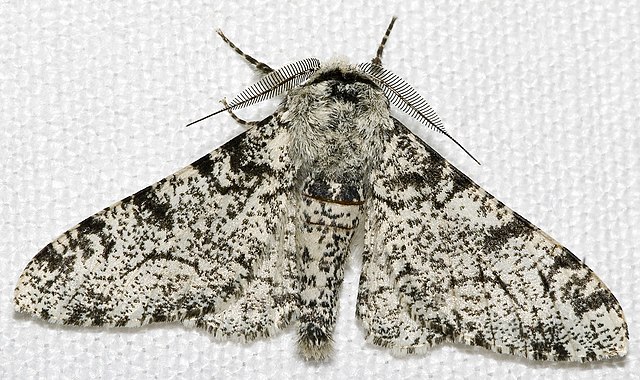
What did the peppered moth do? It changed from a light color to a dark color during the Industrial Revolution.
The peppered moth is native to most places in the northern hemisphere. They are about 5.5 cm with their wings spread out. They fly at night and they are generally a mix of light colors and brown colors, hence their name. Their coloring, and the shape of their wings, helps them camouflage themselves against the trunks of trees. Their caterpillars are actually interesting because they can change their color to match whatever twig they are resting on. They are known as twig mimics because they have dark patches that mimic the patterns of a twig. They can also sense the color of the twig or leaf with their skin and they can alter the color of their skin. Chameleons have this ability.
So, why is the peppered moth famous? It is an often cited example of natural selection at work because it changed its color to match its environment. They managed to change from being a light color to a very dark color to match the soot on the walls during the Industrial Revolution.
The Industrial Revolution took off slowly in the 18th century and began to pick up pace during the early 19th century. There were a series of inventions that compounded on each other, in that one invention made even more inventions and innovation impossible. There were many important discoveries during this time, but, for our purposes, let’s look at steam power and iron smelting. Steam power made machines possible and iron smelting made harder metals available and mass manufacturing started. The thing that made all of these possible was the energy locked up inside coal that can be released when it is burned. When coal is burned, it releases energy, carbon dioxide, and a whole mass of carbon particles that we call soot. These carbon particles are tiny and they can float in the air before alighting on buildings, or being breathed in. In 1700, before the Industrial Revolution started, there were 300 μg/m³ (micrograms per cubic meter) of soot in the air over London. This was mostly caused because people burned coal to heat their houses or cook on. By 1800, it has jumped to 400 μg/m³ and by 1891, it peaks at 623 μg/m³. It started to decline after this because thanks to the Great Stink, cholera outbreaks, and the general level of pollution, a number of measures were passed to try and clean up the town. This rise and fall of the levels of soot in the air is why we are talking about the peppered moth.
Before the Industrial Revolution, all of the peppered moths in the UK were a very light color with flecks of brown on their wings. During the Industrial Revolution, it was noted that all of the peppered moths had become a very dark color. After the Industrial Revolution, the number of light colored moths grew and the number of dark moths fell. So, what happened? It is down to the soot. Before the Industrial Revolution, the light colored moths hid on trees or on buildings and they were camouflaged from their greatest predators, birds. Once the Industrial Revolution got into full swing, the amount of soot built up and the trees and buildings turned black. Light colored moths were very easy for birds to see against the black trees and buildings and the birds ate them. At the same time, a mutation in a moth gave it dark coloring. Before, that moth would have stood out and been eaten, but now it had an advantage and it survived while all the light moths were eaten. They dark peppered moth laid eggs, passed on its genes, and there were more and more dark moths. Come to the end of the Industrial Revolution, there are measures to clean up the skies and the trees and buildings slowly return to their natural colors. Now, the dark moths stick out and the birds eat them. The moth with a genetic mutation that makes it lighter survives and passes its genes on. Within a few generations of moths, they have all returned to their original color. This is how natural selection works, but it is not very often that scientists can watch it happening before their very eyes. And this is what I learned today.
Sources
https://en.wikipedia.org/wiki/Peppered_moth
https://askabiologist.asu.edu/peppered-moths-game/natural-selection.html
https://www.history.com/news/industrial-revolution-negative-effects
https://ourworldindata.org/london-air-pollution
https://www.history.com/topics/industrial-revolution/industrial-revolution
